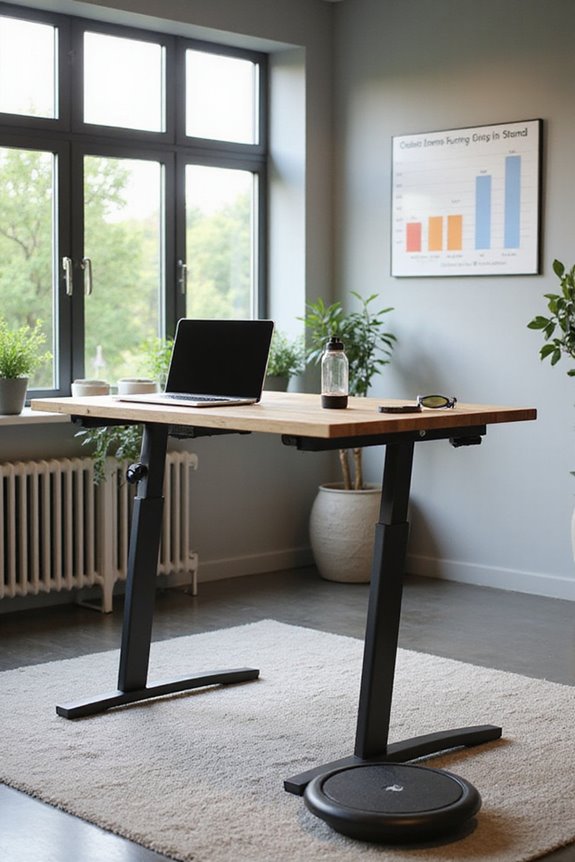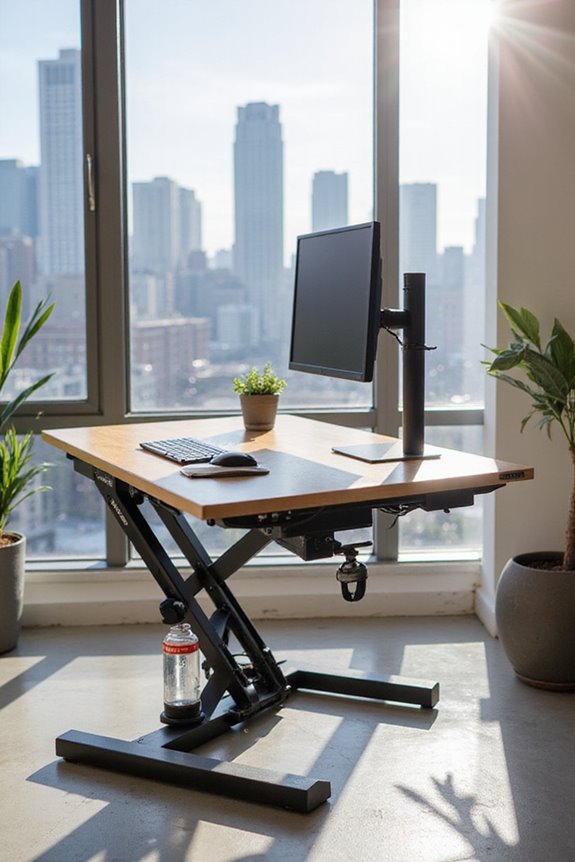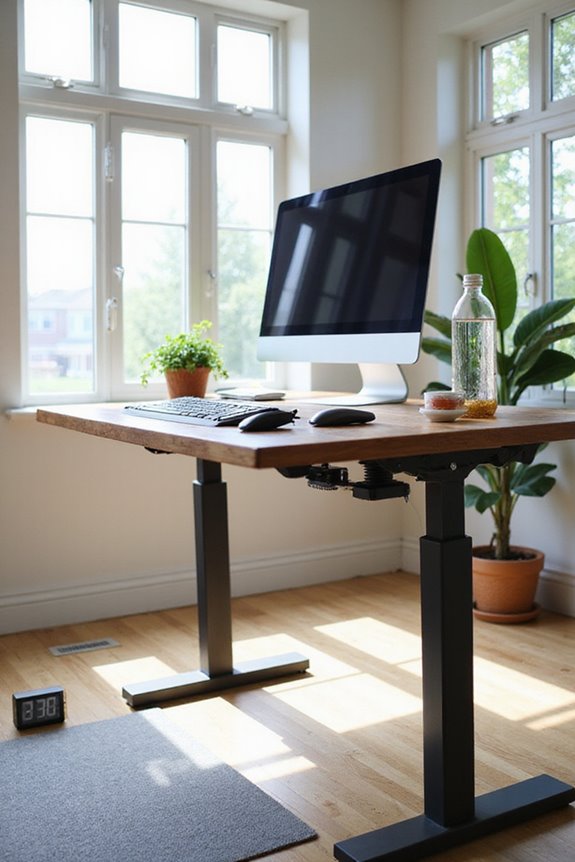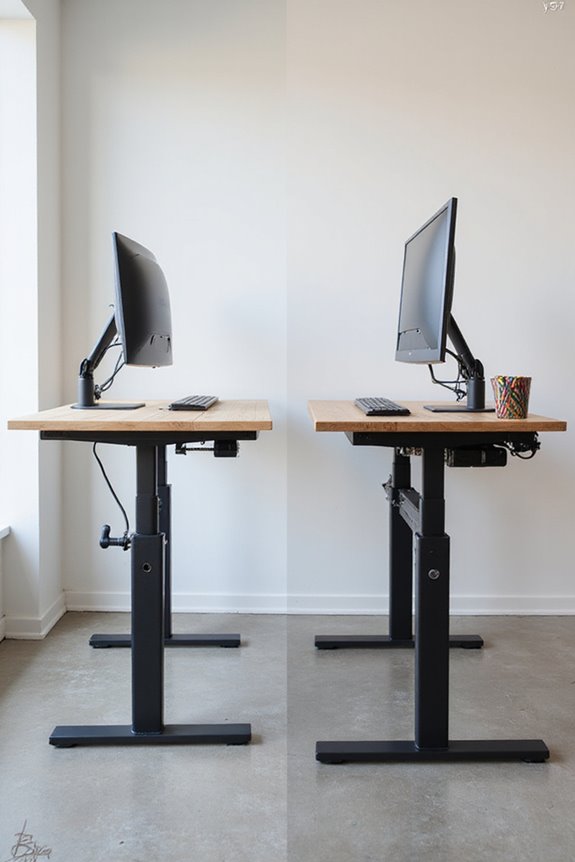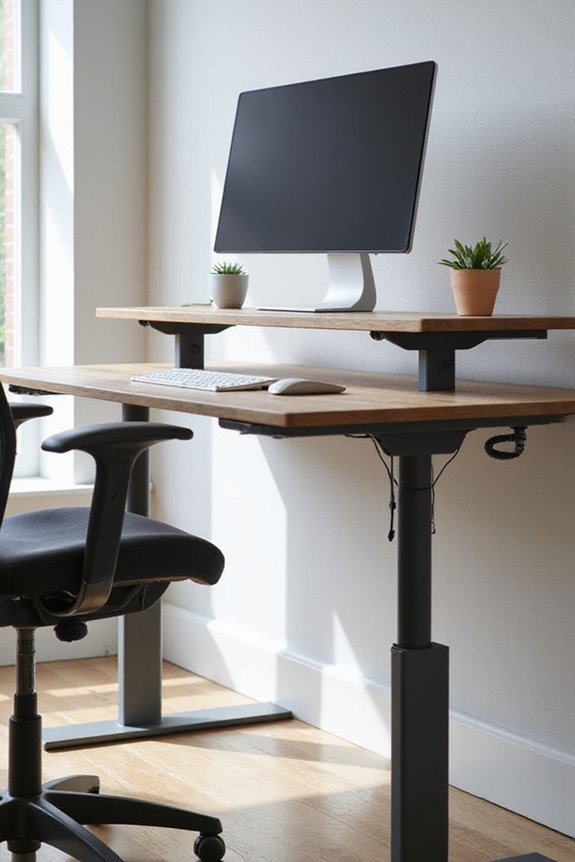Standing desks can promote a slight increase in energy expenditure—about 7.5 kcal per hour—compared to sitting. However, this is not enough for significant weight loss on its own. To effectively manage weight, you’ll need to incorporate a balanced diet and regular exercise into your routine. Besides weight loss, standing desks offer benefits like improved posture, reduced stress, and enhanced productivity. If you’re interested in how to integrate them into a broader health strategy, keep exploring these insights.
Key Takeaways
- Standing desks increase energy expenditure by approximately 7.5 kcal/h compared to sitting, but this is insufficient for significant weight loss.
- Alternating between sitting and standing can lead to an additional 56.9 kcal/day for an 88.9 kg individual.
- Relying solely on standing desks for weight loss is ineffective; diet and exercise are essential for meaningful results.
- Standing desks may help reduce sedentary time, indirectly supporting weight management efforts.
- Improved postural health and enhanced mood from standing may encourage more active lifestyles, benefiting overall well-being.
Understanding Weight Loss Potential of Standing Desks
While many people believe that switching to a standing desk can help with weight loss, the reality is more complex. Standing desk benefits extend beyond weight management, but it’s important to address weight loss misconceptions. Research indicates that while standing desks can increase energy expenditure, the impact is not significant enough to result in meaningful weight loss on their own. For some, especially those who are obese, the effects may be slightly more pronounced, yet still insufficient without additional interventions like diet and exercise. Ultimately, standing desks can promote healthier lifestyle choices and reduce overall sitting time, which may support weight management indirectly. However, relying solely on a standing desk for weight loss isn’t a viable strategy.
Energy Expenditure: How Standing Desks Compare

Switching to a standing desk can have implications beyond just reducing sedentary time; it may also impact energy expenditure. Research shows that using a standing desk can increase energy expenditure by about 0.16 kcal/min compared to sitting. For example, standing burns approximately 7.5 kcal/h more than sitting, and alternating between the two can lead to an additional 56.9 kcal/day for someone weighing 88.9 kg. While these increases in energy expenditure may seem minor, they can accumulate over time, especially for specific populations like children or obese individuals. However, it’s essential to recognize that standing benefits may not remarkably affect everyone, particularly those with a normal BMI. Ultimately, standing desks should be part of a broader approach to enhance physical activity.
Health Benefits Beyond Weight Loss
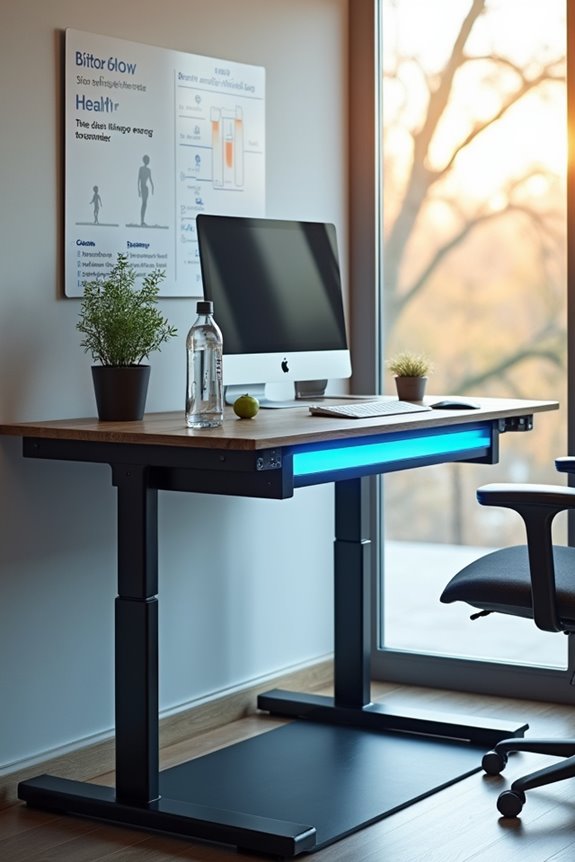
When considering the adoption of a standing desk, it’s important to recognize that the benefits extend well beyond weight loss. One significant advantage is improved postural health. By alternating between sitting and standing, I’ve noticed a reduction in strain on my muscles and joints, which helps prevent discomfort.
Additionally, standing desks contribute to mood enhancement. They’ve been linked to improved mood and reduced stress levels, making my work environment more positive. Standing also promotes better circulation, which can enhance energy and productivity throughout the day. Incorporating a standing desk not only combats the risks of chronic diseases but also supports overall well-being, leading to a healthier lifestyle beyond just managing weight. Moreover, using ergonomic chairs with adjustable lumbar support can further enhance comfort during seated work periods.
The Role of Treadmill Desks in Weight Management
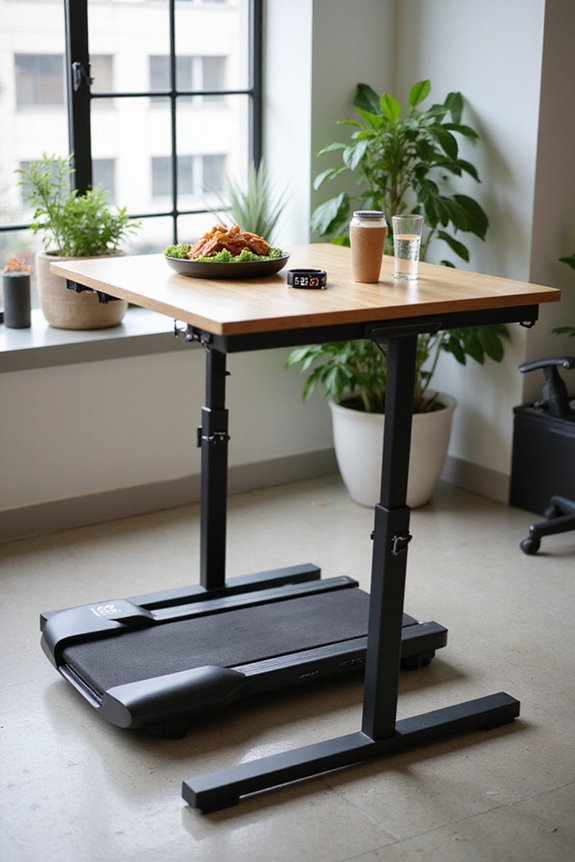
Many people are turning to treadmill desks as an innovative solution for managing weight while working. The treadmill desk benefits extend beyond mere weight loss; studies show an average weight loss of 1.4 kg over a year, with obese individuals losing even more. The key lies in the significant reduction of sedentary behavior, as users typically increase their daily physical activity from 3,353 to 4,460 activity units. This gentle walking while working not only boosts energy expenditure by approximately 197 kcal per day but also maintains work performance. By integrating treadmill desks into our routines, we can facilitate healthier habits that contribute to effective weight management and enhance overall well-being without compromising our productivity.
Impact on Metabolic Outcomes
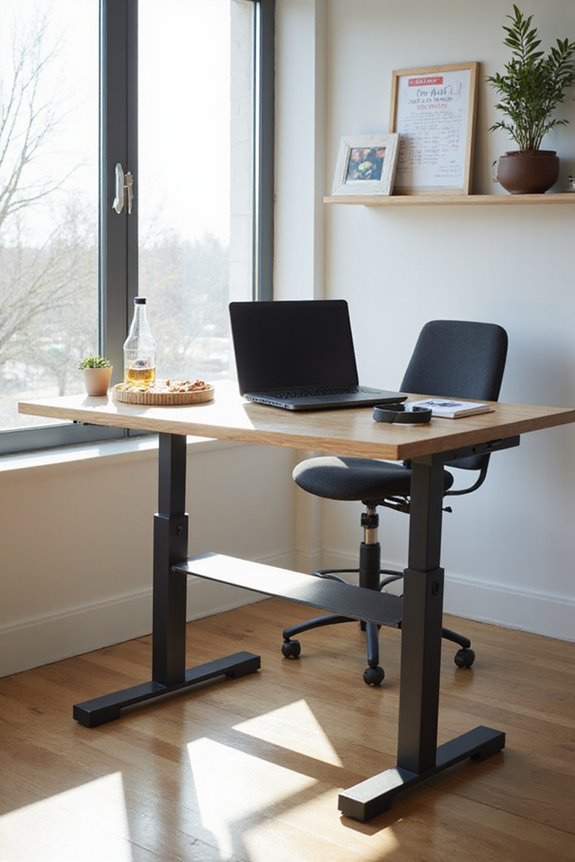
While standing desks have gained popularity as a means to combat the negative effects of prolonged sitting, their actual impact on metabolic outcomes is nuanced. Research indicates that standing desks can lead to modest metabolic improvements, such as reduced insulin resistance and improved fasting triglyceride levels. However, these benefits are often overshadowed by the fact that standing burns only slightly more calories than sitting—approximately 24 extra calories over three hours, equivalent to one carrot.
Despite these positive changes in metabolic markers, users typically see no significant weight loss or change in BMI. Ultimately, the key takeaway is that while reducing sedentary time can enhance metabolic health, standing alone isn’t a panacea for weight management.
Practical Considerations for Using Standing Desks

As you consider integrating a standing desk into your workspace, it’s essential to address several practical aspects that can enhance your experience and effectiveness. First, guarantee an ergonomic setup; the desk height should allow your elbows to be at a 90-degree angle while typing. This minimizes strain on your wrists and shoulders.
Next, look for desk adjustability. An adjustable desk accommodates various preferences and tasks, allowing you to switch between sitting and standing as needed.
Additionally, consider your workspace layout. It may require adjustments to fit the standing desk comfortably. Finally, encouraging colleagues to adopt standing desks can create a healthier environment for everyone. By focusing on these practical considerations, you’ll maximize the benefits of your standing desk.
Transitioning to a Standing Desk: What to Expect

Shifting to a standing desk can present a variety of experiences and adjustments. Expect an adjustment period where your body may need time to adapt to standing for extended durations. Initially, you might experience discomfort, including foot pain and muscle fatigue. Discomfort management is essential; consider investing in supportive footwear and ensuring your desk is ergonomically set up. Gradually increasing your standing time can help ease these initial aches. Incorporating movement, such as stretching or swaying, can also alleviate fatigue. Remember to take regular breaks to sit or move, allowing your body to acclimate effectively. With time and adjustments, you’ll likely notice improvements in posture and overall well-being, making the shift smoother and more beneficial. Additionally, using a desk with quiet motor operation can enhance your experience by minimizing distractions during adjustments.
Standing Desks as Part of a Broader Health Strategy

Integrating standing desks into your daily routine can be a valuable component of a thorough health strategy, especially when combined with other lifestyle changes. While the standing desk benefits include increased energy expenditure and reduced sitting time, relying solely on them won’t lead to significant weight loss.
- Activity Stimulation: Standing desks can motivate you to engage in more non-exercise physical activities.
- Complementary Interventions: Use them alongside diet and exercise for enhanced weight management.
- Health Promotion: They promote healthier lifestyle choices, encouraging long-term health behaviors. Additionally, standing desks can enhance overall productivity and focus by reducing fatigue and encouraging movement throughout the day.
Workplace Wellness Initiatives and Standing Desks
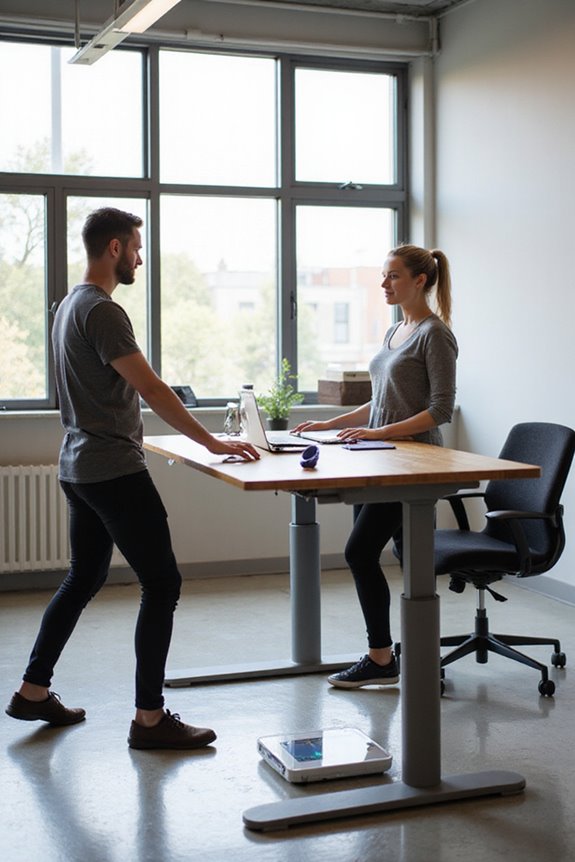
Workplace wellness initiatives have become increasingly popular as organizations recognize the significance of employee health and well-being. More than 60% of organizations now offer such programs, with standing desks being a key component. Their ergonomic design provides a simple, cost-effective way to reduce sedentary behavior, promoting overall employee wellness.
As I’ve observed, standing desks not only encourage movement but also foster a wellness culture within the workplace. Employees who adopt these desks often experience improved posture, reduced discomfort, and even lower stress levels over time. Integration with other wellness programs enhances engagement, making standing desks a crucial part of any all-encompassing health strategy. Ultimately, these initiatives contribute to measurable improvements in health metrics and employee satisfaction. Additionally, ensuring stability and ease of height adjustment in standing desks further enhances user comfort and productivity.
Frequently Asked Questions
Can Standing Desks Improve Posture and Reduce Back Pain?
Studies show that 60% of office workers using sit-stand desks report improved posture benefits and reduced back pain. I’ve also noticed my slouching decrease, making work more comfortable and productive. It’s a worthwhile change!
How Long Should I Use a Standing Desk Each Day?
I’ve found that the ideal duration for daily usage of a standing desk is about 3-4 hours. Starting with shorter intervals and gradually increasing helps me avoid fatigue while reaping the benefits.
Are There Any Risks Associated With Using Standing Desks?
While I love standing desks for their potential benefits, I can’t ignore the risks. Fatigue concerns and potential injuries from prolonged standing remind me that balance and regular movement are vital for my overall health.
Do Standing Desks Come in Different Styles or Designs?
Absolutely, standing desks come in various modern designs. I love how they offer adjustable heights, allowing me to customize my workspace for comfort and productivity. There’s truly a style for everyone’s taste and needs!
Can I Alternate Between Sitting and Standing While Working?
I’ve found that alternating between sitting and standing while working really boosts my productivity. With ergonomic setups, I feel more comfortable and focused, making it easier to tackle tasks effectively throughout the day. Can’t recommend it enough!

